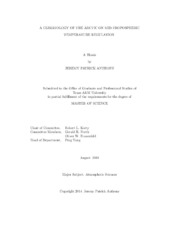| dc.description.abstract | The Arctic is a unique and complex environment. Many factors play a role in determining the long-term climate of the Arctic, including mesoscale weather systems and many complex ice-albedo feedback mechanisms. Previous studies determined using real observations that although 500 hPa temperatures reach -45℃ by mid-November, temperatures very rarely drop below, despite a total loss of incoming solar radiation. This temperature value at 500 hPa follows moist-adiabatically to the surface value of approximately -2℃, which is the freezing point of high-latitude sea water.
Sea ice data was examined using satellite and model data to paint a picture of the environment during three distinct periods in history: the last glacial maximum (twenty-one thousand years ago), the mid-Holocene (six-thousand years ago), and the 20th century. Areal September minimum sea ice extent has reached record lows annually since 2007. Vertical temperature profiles created with CCSM4 model data during these three eras show the atmosphere becoming more moist-adiabatic at high latitudes over time. Saturation potential vorticity allows us to assess the convective environment, and it shows that the Arctic is becoming more tropical over time. Analysis of areal extent where temperatures fall below -45℃ at 500 hPa shows this to be an extremely rare occurrence, and temperatures never fall below -47.5℃, except for very rare occurrences during the last glacial maximum. Transient eddy heat flux is increasing at higher latitudes, and the warm half of a cyclone contains convection (as seen in saturation potential vorticity). In this paper, we present
several lines of evidence supporting a role for intermittent convection in maintaining mid-tropospheric temperatures across climate states of the past twenty-one thousand years. | en |


